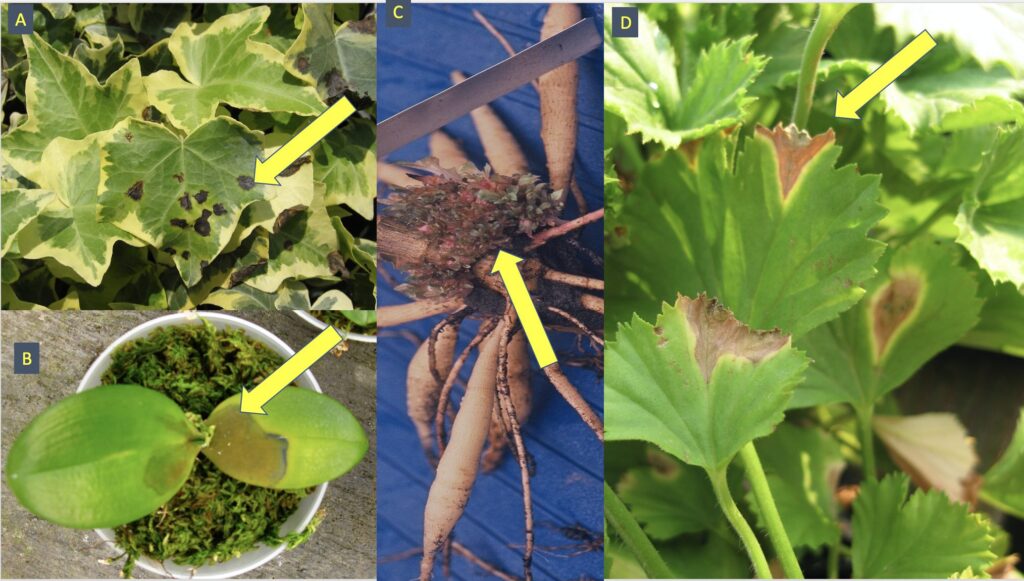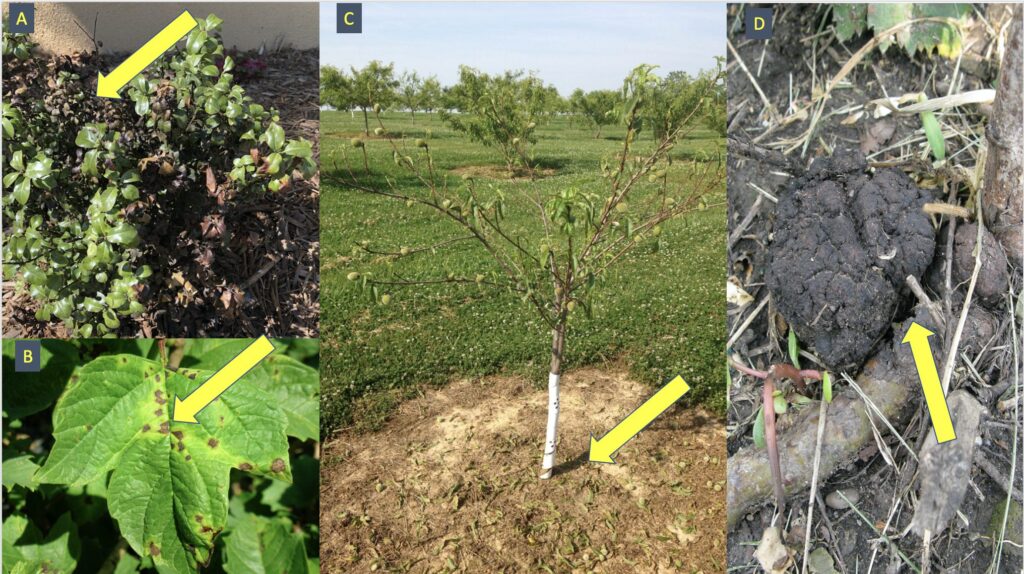“What’s great about bacteria is you have a surprise every day waiting for you because they’re so fast, they grow overnight.” Bonnie Bassler
Bacteria are microscopic, single-celled microorganisms. Their lives are sort of boring: They take in nutrients, they grow, and when the get to a certain size, they split in two. This can happen in as little as 20 minutes, and twenty minutes later, those two daughter cells split into four, and twenty minutes later, those four are eight…and by the end of the day, the bacteria could have reproduced to a degree (272=4,722,366,482,869,645,213,696) that makes rabbits seem like underachievers. It is important to understand this level of bacterial growth for two reasons: 1) you realize that the bacteria are everywhere, even when you don’t see symptoms, and 2) they will become epidemic quickly when conditions meet their needs. Unfortunately, their needs are easily met, and protecting plants from them is a challenge.

Figure 1. a. Ivy with Xanthomonas leaf spot, which caused black, angular lesion; b. Phaleanopsis orchids can become victim to soft rots, particularly if water is left standing in the crown of the plant; c. dahlia infected by Rhodococcus and proliferating stems; d. Xanthomonas blight on geranium.
Bacteria enter through wounds, and natural openings in the plant, usually stomata (microscopic openings on leaves that allow air exchange). Once inside the plant, they produce toxins that kill cells, enzymes that turn cells into mush, hormones that make cells grow in odd ways, chemicals called effectors that suppress plant defense, or a type of slime (called exopolysaccharides) that block water conducting vessels (Fig. 1 – photos A-D). You might know this slime by another name—xanthum gum—a food additive used in salad dressings to thicken it, and make it stick to the leaves. These bacteria stick to plants as well as French dressing sticks to lettuce!

Figure 2. a. Fire blight on cotoneaster causes blackened foliage; b. angular leaf spot on hydrangea caused by Xanthomonas; c. Bacterial leaf spot of peach also infects and defoliates ornamental plums and cherries; d. Crown gall.
After the bacteria get into the leaves and begin to reproduce, symptoms develop. These symptoms usually appear between the leaf veins resulting in discrete, angular spots. Yellow or red halos often develop around the lesion. As lesions coalesce, the damage may appear more like blight, as opposed to a discrete spot (Fig. 2). In the last year, we’ve been seeing a lot of Xanthomonas leaf spot and Pseudomonas leaf spot on bedding plants, particularly begonia, in addition to vegetable and herb starts. In nursery crops, the fire blight pathogen, Erwinia amylovora, is a common and devastating problem (Table 1).
Table 1. Plant hosts and the causal bacterium that cause disease commonly observed in Indiana.
| Plant Host | Type of Disease | Pathogen |
| Begonia | Leaf spot and blight | Xanthomonas axonopodis pv.begonia |
| Cyclamen | Soft rot | Pectobacterium carotovorum |
| Dahlia | Leafy gall/ Bud proliferation | Rhodococcus fascians |
| Euonymous | Crown gall | Agrobacterium tumefaciens |
| Geranium | Leaf spot | Pseudomonas spp. |
| Hedera | Leaf spot | Xanthomonas hortorum |
| Hydrangea | Leaf spot, blight | Xanthomonas campestris |
| Impatiens | Leaf spot | Pseudomonas ssp. |
| Lavandula | Leaf blight | Xanthomonas hortorum |
| Lilac | Leaf blight | Pseudomonas syringae |
| Malus, Pyrus, other rose family members | Fire blight | Erwinia amylovora |
| Narcissus | Soft rot | Pectobacterium carotovorum |
| Pelargonium | Leaf spot | Pseudomonas spp. |
| Bacterial wilt | Ralstonia solanacearum | |
| Bacterial wilt/blight | Xanthomonas hortorum | |
| Soft rot | Pectobacterium carotovorum | |
| Petunia | Leafy gall/ Bud proliferation | Rhodococcus fascians |
| Poinsettia | Leaf spot | Xanthomonas axonopodis
pv. poinsettiicola* |
| Soft rot | Pectobacterium carotovorum | |
| Prunus | Bacterial canker | Pseudomonas syringae pv. syringae |
| Leaf spot, shothole | Xanthomonas prunii | |
| Rosmarinus | Leaf spot | Pseudomonas cichorii |
| Rudbeckia | Leaf spot | Pseudomonas cichorii |
| Salix | Crown Gall | Agrobacterium tumefaciens |
| Salvia | Leaf spot | Pseudomonas syringae |
| Sedum | Soft rot | Pectobacterium carotovorum |
| Vaccinium | Leaf spot, blight | Xanthomonas spp. |
| Zinnia | Leaf spot | Xanthomonas campestris pv. zinniae |
Even with a microscope, most plant infecting bacteria look surprisingly boring, like a pill–A very, very small pill. A key point to remember is that different species of Xanthomonas or Pseudomonas infect different species plants, which is indicated by the term ‘pathovar’, meaning variety of bacteria pathogenic to one host. Xanthomonas campestris pv. zinniae infects zinna, whereas Xanthomonas vesicatoria infects tomatoes and peppers. So, if you have infected zinnias, this pathogen will not spread to your tomatoes or peppers. Unfortunately, this pathogen produces symptoms that look a lot like Pseudomonas cichorii, a major pathogen on chrysanthemum, ivy, basil, and other plants. Unlike the host specific Xanthomonas species, P. cichorii is not picky about its host. Neither is the soft rot pathogen of bulbs and many bedding plants, Pectobacterium carotovorum. In fact, host specificity is not known to exist. A laboratory diagnosis is needed to confirm which type of bacterial problem your plants have.
Regardless of which bacteria you are battling, there are certain key management strategies that reduce bacterial growth and spread. Bacterial diseases of the foliage are favored by prolonged periods of leaf wetness, and high relative humidity. Due to bacterial reproduction, they are everywhere, including all over asymptomatic plants. With a stressed or injured host, and wet conditions, splashing water easily spreads bacteria to overlapping and nearby plants. These bacteria then enter the leaf through injuries and natural openings, with water facilitating spread and infection. Thus, the longer the plants are wet, the greater the opportunity there is for infection to occur, and the more you handle or work around plants, the more likely they will end up damaged. Key management points at this stage is reducing leaf wetness, minimizing splashing from irrigation, and avoid handling plants when they are wet. Workers should wash their hands regularly, and especially after handling infected plants, or plant debris. But hey, in the time of COVID, we should be doing this anyways! Any tools used should be disinfected (bleach, trisodium phosphate, or commercial disinfectant/disinfectant), as well.
Further protection against plant diseases can be provided by the use of copper-based pesticides. Copper is a multi-purpose biocide, capable of killing bacteria, water-molds and fungi—and damaging plants if care isn’t taken. When using copper, be sure to use non-acidified water to minimize the risk of phytotoxicity. Frequent applications of copper are also recommended. Keep in mind that this is copper, and it is definitely not a ‘silver bullet’! There are no pesticides that will cure infected plants or completely stop the spread of bacterial diseases. Thus, prevention is the key.
To prevent bacterial diseases from becoming established in your operation requires good sanitation practices, and a certain degree of ruthlessness. Diseased plants and plant debris should be promptly removed from the growing area. This material should not be composted, nor should you re-use contaminated potting media.
Some bacterial disease outbreaks in greenhouses or nurseries begin with the use of infected seeds or transplants (which may be asymptomatic). If you suspect this, be sure to provide as much information as you can regarding the outbreak (sowing date, growing media, management, etc.), and also provide the source of seed/plants when submitting samples for diagnosis. Not only can your diagnostic lab diagnose the dots, they may be able to connect them, and identify the source of bacterial outbreaks.
Some seed may be treated by surface sterilization. Keep in mind that surface sterilization will reduce germination, so it is only recommended if you have a history of problems with a certain crop or supplier. A general formula for tomato and pepper seed is: Forty minutes with continuous agitation in 2 parts Clorox Liquid Bleach (5.25% sodium hypochlorite) plus 8 parts water (e.g. 2 pints Clorox plus 8 pints water). Use 1 gallon of this solution for each pound of seed. Be sure to prepare fresh solution each time you treat seed, and then rinse seed in clean water and allow to dry prior to planting. Keep in mind that smaller seeds will require less time, or even less bleach. Test each seed crop before implementing, or you may create a new problem for yourself called ‘zero germination’! Use 50 seeds, treated and untreated, in a germination test (https://extension.umaine.edu/publications/1013e/f) to compare and observe how lethal your seed disinfecting method is. Extended treatment times and higher rates of bleach will kill more bacteria—and more seeds. Remember to make sure your treatment isn’t worse than the disease!
Bacterial growth is favored by warm, wet conditions (70-85 degrees F). Bacteria need opening or wounds for entry, so avoid working around plants when they are wet—any injury provides an infection court AND water to help spread bacteria. Avoid working around plants when wet. Improve plant spacing to reduce humidity and increase drying of plants, avoid watering later in the day, and overwatering plants. Bacteria can spread by splashing, wind driven rain, and even sprayers. Due to issues of copper resistance in many plant pathogens, and the reality that any applications will increase surface moisture and spread, eradicate any symptoms of bacterial disease prior to applying copper fungicides.
For woody ornamentals, pruning the infected area and disposal is key. However, keep in mind that the infection commonly extends beyond the symptomatic tissue. In other words, remove more—at least 12” more—beyond to where the symptoms end, to eradicate any traces of the pathogen.